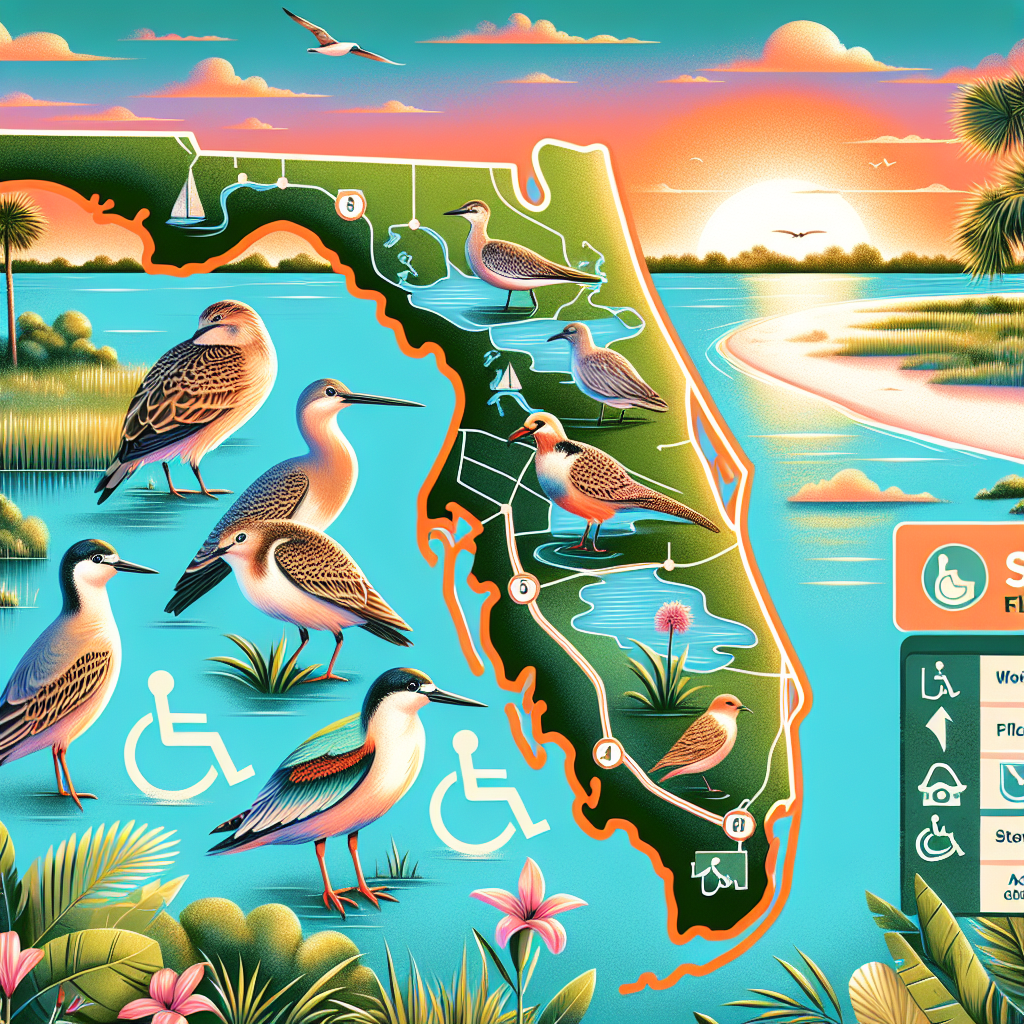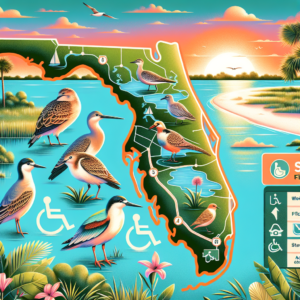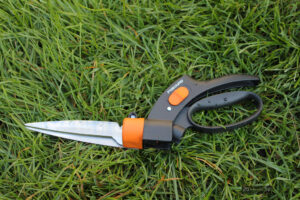
Florida’s Finest Feathers: A Guide to Wheelchair-Friendly Birdwatching Spots
Imagine sitting comfortably, surrounded by the soothing sounds of nature, as a parade of colorful birds flutters before your eyes. This is the joy of birdwatching, a pastime that connects us with the beauty of the natural world. It’s a hobby that doesn’t discriminate, and Florida is a prime spot where accessibility meets avian amazement. Let’s embark on a journey to discover the top birdwatching destinations in the Sunshine State that are perfect for wheelchair users.
Article-at-a-Glance
- Discover Florida’s wheelchair-friendly birdwatching destinations.
- Explore the therapeutic benefits of birdwatching for physical and mental health.
- Learn about the accessible trails and amenities at Merritt Island National Wildlife Refuge.
- Gain insight into the importance of accessibility in natural spaces.
- Unveil the mental health advantages of connecting with nature through birdwatching.
Why Birdwatching is a Breath of Fresh Air
Birdwatching is more than just a leisure activity; it’s a gateway to freedom for many seniors. With the right locations, it can be easily accessible, allowing you to immerse yourself in nature without barriers. Whether you’re an avid birder or just looking for a peaceful way to spend your day, birdwatching offers a unique blend of relaxation and excitement. It’s an opportunity to witness the wonders of wildlife up close, all while enjoying the great outdoors.
Understanding Accessibility in Natural Spaces
Accessibility in natural spaces is crucial. It ensures that everyone, regardless of mobility challenges, can enjoy the beauty and serenity of the outdoors. This means well-maintained paths, clear signage, and amenities that cater to different needs. It’s about creating an inclusive environment where the joy of discovering nature’s marvels is available to all. In Florida, many birdwatching spots have been thoughtfully designed with this in mind, setting the standard for accessible nature experiences.
Benefiting from Birdwatching: Nature’s Therapeutic Effects
The benefits of birdwatching extend far beyond the joy of spotting a rare species. It’s a form of therapy, offering a multitude of health advantages that can enhance your quality of life. The combination of fresh air, gentle exercise, and the calming effect of being in nature can do wonders for your well-being. Let’s look at how birdwatching can be a source of physical and mental rejuvenation.
Physical Wellness and Outdoor Activities
Engaging in birdwatching encourages gentle physical activity. As you navigate through accessible paths or wheel along boardwalks, you’re supporting your cardiovascular health and maintaining your mobility. Plus, the fresh air is excellent for your lungs, and the vitamin D from sunlight boosts your immune system. These small activities add up, contributing to a healthier lifestyle.
Mental Health Advantages of Birdwatching
It’s not just your body that benefits from birdwatching; your mind does, too. The peacefulness of nature acts as a natural stress reliever, helping to lower anxiety and elevate mood. The focus required to spot and identify birds can also be a meditative practice, keeping your mind sharp and engaged. It’s a tranquil escape that nurtures your mental health, offering a sense of accomplishment with every new bird you add to your list.
1. Merritt Island National Wildlife Refuge

First on our list is the Merritt Island National Wildlife Refuge, a haven for bird enthusiasts that’s as accessible as it is beautiful. Located near the Kennedy Space Center, this refuge is home to a diverse range of bird species, making it a must-visit spot for anyone interested in birdwatching.
Contained within this 35-mile long barrier island is a rich abundance of plants and animals from both the subtropical and temperate climate zones. Merritt Island National Wildlife Refuge is strategically located on the Atlantic Flyway, a major bird migration corridor, (358 species of birds have been identified on the refuge), and it is a key resting stop for many migratory bird species. The refuge’s habitats support one of the highest numbers of endangered and threatened species found within the refuges of the National Wildlife Refuge System. This unique relationship the refuge shares with NASA bears testimony that nature and technology can coexist.
Accessible Trails and Boardwalks
The refuge boasts over 140,000 acres of land, with trails and boardwalks designed for easy wheelchair access. The well-maintained paths ensure a smooth ride, allowing you to explore the habitats of herons, egrets, and perhaps even spot a bald eagle without the worry of navigating rough terrain. It’s a place where accessibility is as much a priority as conservation, ensuring a welcoming experience for all visitors.
Noteworthy Bird Species to Spot
At Merritt Island National Wildlife Refuge, the birding checklist is impressive, with over 300 species recorded. Keep your binoculars ready for the spectacular sight of roseate spoonbills, their pink feathers a splash of color against the greenery. The majestic osprey can be seen soaring overhead, while the elusive American bittern might just make an appearance among the reeds. Every visit promises a chance to marvel at a new species, making each trip a unique adventure.
Visitor Center and Amenities for Comfort
The Visitor Center at Merritt Island is a treasure trove of information, with friendly staff ready to enhance your birdwatching experience. Wheelchair-accessible restrooms, picnic areas, and parking make your visit comfortable and stress-free. The center also offers free loaner wheelchairs, ensuring everyone has the opportunity to explore and enjoy the refuge’s offerings.
2. Corkscrew Swamp Sanctuary
Next, we venture into the heart of the Everglades ecosystem at Corkscrew Swamp Sanctuary. This ancient environment, with its towering cypress trees, is a world apart and a birdwatcher’s dream come true.
Wheelchair-Friendly Boardwalk Adventure

The sanctuary features a 2.25-mile boardwalk that meanders through pine flatwoods, wet prairie, and finally into the largest old growth Bald Cypress forest in North America. This boardwalk is designed to be wheelchair-friendly, ensuring that everyone can experience the magic of the swamp without barriers. The smooth path allows for easy navigation, inviting you to journey through the heart of this wild place at your own pace.
Diverse Ecosystems and Bird Diversity
Each turn of the boardwalk at Corkscrew Swamp Sanctuary reveals a different layer of the ecosystem, each with its own community of birds. See the list of species and download a list from Corkscrew Swamp Sanctuary Boardwalk Bird List From the ghostly Wood Storks to the vibrant Painted Buntings, birdwatchers are treated to a kaleidoscope of avian life. The sanctuary is also a critical breeding ground for the endangered Florida Panther, adding to the sense of wonder and importance of this protected area.
Guided Tours and Educational Programs
Enhance your visit with guided tours and educational programs offered by the sanctuary. These programs are designed to be accessible and informative, providing insights into the birds, plants, and wildlife of the swamp. Knowledgeable guides can tailor the experience to your interests, making your birdwatching outing both enlightening and enjoyable.
3. J.N. “Ding” Darling National Wildlife Refuge

Our journey brings us to the famous J.N. “Ding” Darling National Wildlife Refuge on Sanibel Island. Known for its abundant bird populations and stunning vistas, it’s a place where nature’s beauty is always on full display. From the site:
“The best place to start is the FREE Visitor and Education Center. There you can get information and brochures, visit the nature store, explore our exhibits and visit America’s best restrooms. Exhibits feature information about our ecosystems, the work of Jay Norwood “Ding” Darling, migratory flyways and a hands-on area for children.
Then you can drive the four-mile Wildlife Drive, access three walking trails and two canoe launches from it. The refuge is home to more than 245 bird species, so birdwatching and photography are fabulous. Or sign up for a tram tour offered by Tarpon Bay Explorers to see the Wildlife Drive.”
Drive-Through Tours: A Close-up Encounter
The refuge offers a unique drive-through experience along its Wildlife Drive. This four-mile route allows you to enjoy birdwatching from the comfort of your vehicle, making it perfect for those who prefer not to or are unable to venture out on foot or wheelchair. It’s an intimate encounter with nature, where each turn can reveal an unexpected sighting.
Birdwatching from the Comfort of Your Vehicle
As you travel the Wildlife Drive, every stop is an opportunity to observe birds in their natural habitats. You might spot an Anhinga drying its wings in the sun, or a flock of White Pelicans gliding gracefully over the water. The convenience of birdwatching from your vehicle means you can take your time, enjoy the sights at your own pace, and savor the moments that make birdwatching such a special activity.
Facilities and Accessibility Services

The J.N. “Ding” Darling National Wildlife Refuge prides itself on being accessible to all visitors. The refuge offers a variety of facilities and services to ensure a comfortable experience, including accessible restrooms and parking spaces. The visitor center is equipped with exhibits that are at a comfortable height for everyone, and there are also free wheelchair rentals available on a first-come, first-served basis. The staff is always ready to assist, ensuring that your birdwatching adventure is hassle-free and enjoyable.
4. Everglades National Park
Everglades National Park is not just a national treasure; it’s a testament to the beauty and diversity of Florida’s wildlife. This vast wilderness is home to an array of birds that call the river of grass their home. The park’s commitment to accessibility makes it a perfect spot for birdwatchers of all abilities to explore and enjoy.
An American Icon: Accessible Paths to Nature
The park’s trails and facilities are designed with accessibility in mind. Boardwalks and paved paths, like the Anhinga Trail, allow wheelchair users to navigate through the park with ease. These trails offer close-up views of the park’s unique ecosystem and its inhabitants, providing an immersive experience that is both safe and convenient.
Year-round Avian Attractions
Everglades National Park is a year-round hotspot for birdwatching. Whether it’s the graceful flight of the Great Egret or the impressive wingspan of the Osprey, there’s always something to see. The park’s diverse habitats support a wide range of bird species throughout the year, making any time a good time to visit.
Rangers and Accessibility Resources
The park rangers are a valuable resource for visitors with accessibility needs. They provide information on the best spots for birdwatching and can offer tips on how to make the most of your visit. The park also provides all-terrain wheelchairs upon request, ensuring that even the most remote areas are within reach.
5. Fort De Soto Park

Fort De Soto Park is a gem on Florida’s Gulf Coast, offering some of the best beach birdwatching opportunities in the state. The park’s beaches are a haven for birdwatchers, with accessible features that make the experience enjoyable for everyone.
Accessible Beach Birding
The park’s beaches have been thoughtfully designed to accommodate wheelchair users. With hard-packed sand and boardwalks leading to prime birdwatching spots, you can comfortably observe shorebirds and seabirds as they go about their daily routines. The sight of a Snowy Egret wading through the shallows or a group of Black Skimmers flying in unison is truly unforgettable.
Discover the ease and convenience of exploring Fort De Soto Park for wheelchair users and those with mobility challenges. The park offers a well-maintained, multi-use trail that caters to wheelchair users, bicyclists, rollerbladers, runners, and walkers. Experience the accessibility of the park facilities, including the gift shop, snack shop, fort, Gulf pier, bait shop, and a barrier-free nature trail stretching 2,200 feet. All parking lots are equipped with disability parking spots and access lines.
They understand the importance of accessible parking, which is why they offer special privileges for visitors with disability plates or placards – park in a disability spot for free! While beach access ramps are available from the parking lots to the sidewalk, please note that Mobi-Mats are not present on the beaches. However, they provide five beach wheelchairs for your convenience. Call 727-582-2100, ext. 2 during the week to request a beach wheelchair, or visit the campground office on weekends.
Migratory Pathways and Unique Habitats
Fort De Soto Park is strategically located along the Great Florida Birding Trail, making it a critical stopover for migratory birds. The park’s varied habitats, including mangroves, wetlands, and sandy beaches, attract a diverse array of bird species. This makes it an ideal spot for observing different behaviors and interactions, especially during the migration seasons.
Wheelchair Rental and Beach Access Points
To ensure that all visitors can enjoy the beauty of the park, Fort De Soto offers beach wheelchair rentals at no cost. These specially designed chairs can easily navigate the sandy terrain, allowing you to get closer to the water’s edge and the birds that frequent it. The park also features accessible beach access points, complete with ramps and mobility mats, providing a seamless transition from the parking area to the beach.
Planning Your Birdwatching Adventure
Preparing for a birdwatching trip is part of the fun. You’ll want to make sure you have everything you need for a comfortable and successful day of birding. Here’s a checklist to help you pack.
Things to Bring: A Checklist for Successful Birding
- Binoculars for a clear view of the birds from a distance.
- A field guide to help identify the species you encounter.
- A hat and sunglasses to protect you from the Florida sun.
- Sunscreen and insect repellent to keep you safe from sunburn and bites.
- A lightweight, long-sleeved shirt and pants for additional protection.
- Comfortable, sturdy shoes, even if you’ll be staying on paved paths.
- Water and snacks to stay hydrated and energized.
- A camera or smartphone for capturing photos of your feathered friends.
- A notebook and pen for jotting down sightings or notes.
Navigating Weather and Terrain
Florida’s weather can be unpredictable, with sudden showers and strong sunshine. Always check the forecast before heading out and be prepared with rain gear and plenty of water. The terrain in birdwatching areas can vary from paved paths to boardwalks, so ensure your mobility aids are suitable for the environment you’ll be exploring.
Engage with Local Birdwatching Communities
Joining a local birdwatching group can enrich your experience. Members often share tips on the best spots and times for sightings, and you might even make new friends who share your passion. Check community boards, social media groups, or ask at the visitor centers to find a group that’s right for you.
Florida Birdwatching Calendar: Best Times to Visit
Florida’s birdwatching season offers something special year-round, but there are peak times you won’t want to miss. Here’s a guide to the best times to visit.
Migratory Seasons and Breeding Periods
The spring and fall migrations are spectacular, as countless birds travel through Florida. Spring brings courtship and nesting behaviors, while fall sees the arrival of winter residents. Breeding season, typically from March to August, is also a fantastic time to observe birds in their most vibrant plumage.
Month-by-Month Birdwatching Guide
January to March is great for spotting wintering waterfowl and raptors. April and May are peak migration months for songbirds. June through August is hot but rewarding with breeding birds and chicks. September and October bring another wave of migrants, and November to December offers a chance to see early winter arrivals.
Elevating Your Birdwatching Experience
With the right gear and aids, birdwatching can be even more enjoyable. Here are some recommendations for items that can enhance your birding adventures.
Recommended Gear and Mobility Aids
Consider a lightweight, portable chair for comfort during extended outings. A high-quality pair of binoculars with image stabilization can make a big difference, especially if your hands are not as steady as they used to be. For those using wheelchairs, look for binoculars with a wide field of view to make tracking birds easier. And don’t forget a birding app for your smartphone, which can offer audio clips of bird calls to help you identify species by sound.
Birdwatching Apps and Digital Resources
Technology has made birdwatching even more accessible and enjoyable. A variety of apps and digital resources are available to help you identify birds, log your sightings, and connect with other bird enthusiasts. Apps like Audubon Bird Guide and Merlin Bird ID are user-friendly and can turn your smartphone into a powerful field guide. Websites such as eBird allow you to contribute to citizen science projects by sharing your observations. Embrace these digital tools to enhance your birdwatching experience and keep your life list growing.
Frequently Asked Questions (FAQ)
What are the best times of year for birdwatching in Florida?
The best times for birdwatching in Florida are during the spring and fall migrations, from March to May and from August to October. These are the periods when you can see a variety of migratory birds passing through the state. However, Florida’s mild climate means that birdwatching can be a year-round activity, with different species to see in each season.
Are there any birdwatching guides or tours catered to wheelchair users?
Yes, there are several birdwatching tours and guides in Florida that cater to wheelchair users. These tours often have knowledgeable guides who are familiar with the needs of birdwatchers with mobility challenges. They can provide a fulfilling experience by taking you to the most accessible spots where you’re likely to have the best sightings.
How can I get involved with the local birdwatching community as a newcomer?
Getting involved with the local birdwatching community is as simple as reaching out. Join local birdwatching clubs or online forums, attend meetings or bird walks, and participate in bird counts or other citizen science events. These communities are typically welcoming and eager to share their knowledge with newcomers.
What types of birds can I expect to see in these accessible hotspots?
In these accessible hotspots in Florida, you can expect to see a wide variety of birds, including wading birds like herons and egrets, waterfowl such as ducks and ibis, raptors like ospreys and eagles, and many migratory songbirds. Each location has its own unique inhabitants, so you might see different species at each one.
Are service animals allowed in these birdwatching locations?
Service animals are generally allowed in most outdoor public birdwatching locations, including national wildlife refuges and parks. However, it’s always a good idea to check the specific regulations of the site you plan to visit, as there may be restrictions in certain sensitive areas to protect the wildlife.
In conclusion, birdwatching in Florida offers an accessible and enriching experience for nature enthusiasts of all mobility levels. With the right planning and resources, you can immerse yourself in the state’s diverse avian life and reap the many benefits of this peaceful pastime. So grab your binoculars, download a birding app, and set out on an adventure that’s sure to lift your spirits and bring you closer to the natural world. Whether you’re a seasoned birder or just starting out, the accessible birdwatching hotspots of Florida are waiting to be explored, promising new discoveries with every visit.



